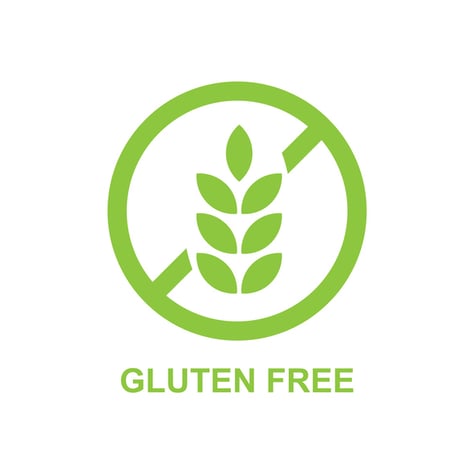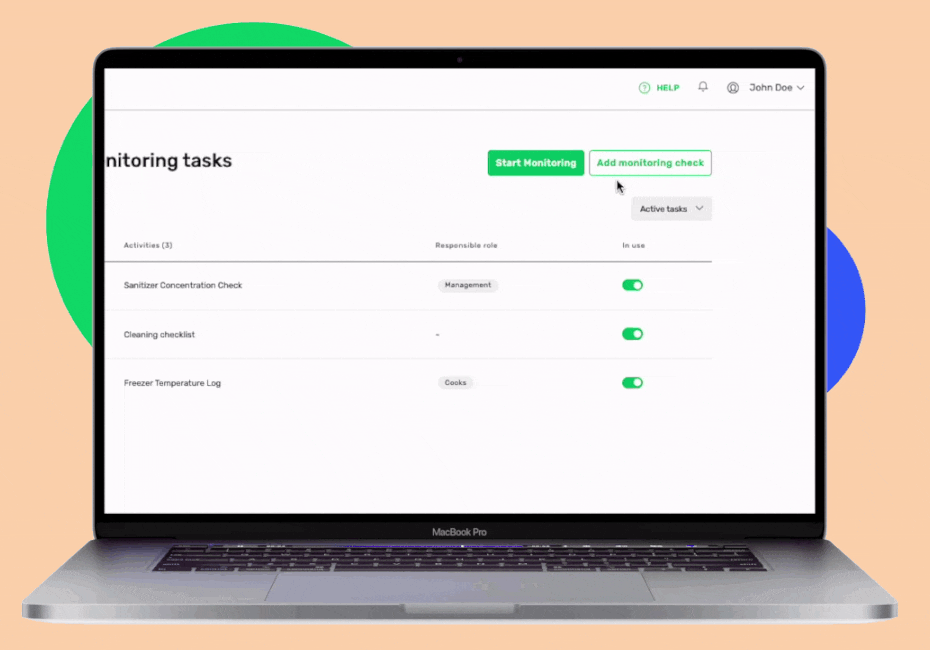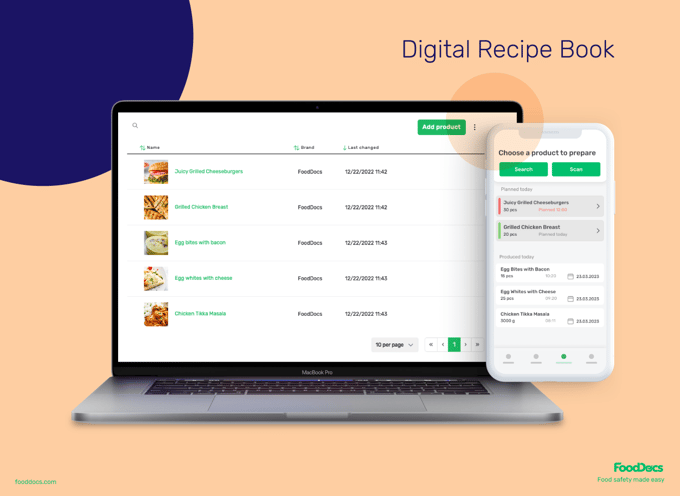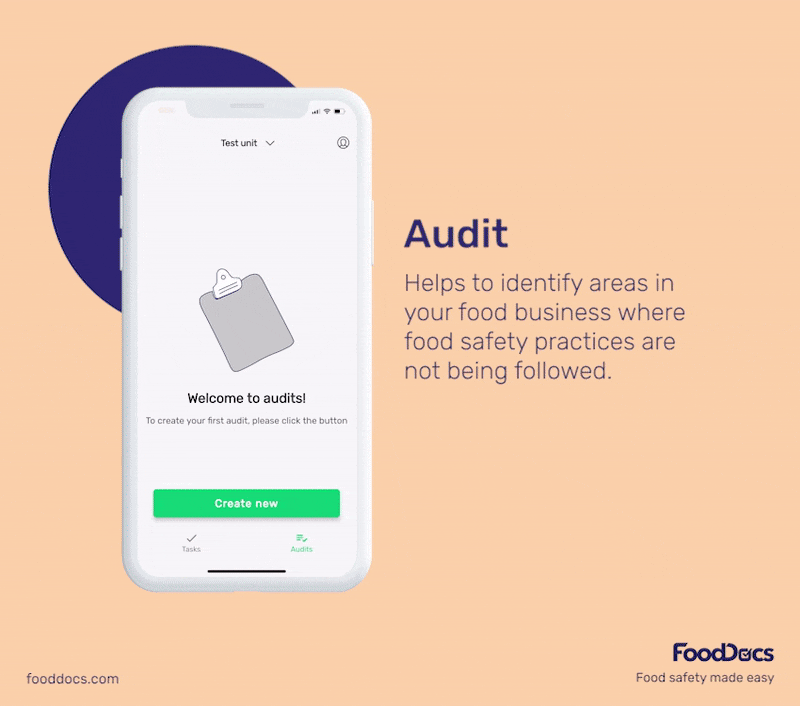Why Is Food Safety Important In Healthcare? Healthcare Leaders Guide
Learn challenges healthcare foodservice teams face today and key food safety practices to protect vulnerable patients. Get a free healthcare leader...
In today's food climate, when dietary preferences and health considerations are more considered, gluten-free products have become more in demand.
This trend helps individuals with sensitivities to the protein gluten, such as people with Celiac Disease, to live a healthier lifestyle without the negative effects of gluten on them.
This article discusses gluten-free certification for food businesses, exploring its significance, the requirements for obtaining it, and its advantages to food businesses.
WHAT WE'LL COVER:
Gluten is a protein found in grains, primarily in wheat, barley, and rye, and is found in products containing flours of these grains. The protein gluten gives the dough its elasticity, allowing bread and other baked goods to rise and maintain shape after baking. Gluten is present in an extensive range of products in the food industry.
Businesses get certified against gluten use primarily to cater to individuals with Celiac Disease or non-Celiac gluten sensitivity.
Some individuals are either intolerant or allergic to gluten, which is why it is considered to be one of the major food allergens in many different countries.
Food businesses handling gluten-containing products are advised to use tools such as a food allergy warning sign and an allergen poster. These tools help educate food handlers and consumers on the risks of gluten.

The term "Gluten-free" signifies that a particular product is made and produced in a way that eliminates the presence of gluten from any gluten-containing grains. This includes any potential cross-contact from other operations near the production area of a food item. Contamination of gluten can be considered a chemical hazard in the food business.
To become gluten-free, food businesses, such as production and food service, must carefully choose their ingredients and exclude any gluten-containing ingredients. All raw materials used to make a gluten-free product must be ensured to be free of protein in their individual product specification sheets.
Businesses must take measures to prevent contamination with gluten-containing ingredients during production. This includes cleaning equipment thoroughly between batches and segregating gluten-free ingredients from gluten-containing ones.
There are no rules in which products can be labeled as gluten-free aside from the absence of gluten. Even naturally gluten-free foods, such as water, can carry the label.
Being gluten-free is often indicated on the food label of a product. It is important to know that the terms "gluten-free" and "certified gluten-free" are not interchangeable.
Overall, "gluten-free" represents a commitment by food businesses to provide safe and suitable food options for individuals who need to avoid gluten due to medical conditions, such as consumers with Celiac disease or dietary preferences.
The label "Certified Gluten-Free" indicates that a food product was evaluated using a specific certification process that verifies the absence of gluten. It ensures customers and businesses that the product has met a broad range of gluten-free standards established by recognized certifying organizations.
Certified gluten-free products have been evaluated and verified by an independent third-party organization. This organization specializes in food safety and gluten testing, ensuring impartiality and reliability in the certification process. This also indicates that the product was tested to determine if the product's gluten content is below the threshold.
Different countries may have their own established threshold, but the most common is very low (e.g., 20 parts per million (ppm) or less).
In the United States, for example, the Gluten-Free Certification Organization (GFCO) and the Food and Drug Administration (FDA) have established guidelines and gluten-free labeling laws for certification. In other countries, different certifying bodies and standards may apply, but the core concepts of strict testing, adherence to strict gluten-free guidelines, and third-party certification remain consistent.
Ensure that your gluten-free products are handled correctly and secure a certification efficiently with the help of FoodDocs' AI-powered Food Safety Management System. With the help of our smart software, you can create customizable monitoring tasks based on gluten-free standards. You can also get a clear allergen matrix as a guide and proof that your ingredients are gluten-free.
As previously mentioned, products labeled as gluten-free food do not necessarily mean that they are certified gluten-free.
In general, while both terms indicate safety for consumers with gluten sensitivity, the key difference is the level of assurance and verification.
Here is a quick rundown of the differences between the two labels:
| Gluten-Free Food | Certified Gluten-Free Food | |
|---|---|---|
| Definition | Contains no gluten or ingredients with gluten-based grains. | Has undergone a rigorous certification process to ensure it meets strict gluten-free standards. |
| Labeling | May bear a "gluten-free" label or claim based on the manufacturer's own testing and standards. | Bears a "certified gluten-free" label or mark. |
| Food testing | Testing may or may not be conducted by the manufacturer. | Undergoes thorough testing for gluten content. |
| Third-Party Verification | Not subject to third-party verification unless voluntarily certified. | Independently verified and certified by a recognized certifying organization. |
| Cross-contact | Potential for cross-contact with gluten-containing ingredients may exist, depending on the manufacturer's practices. | Implements strict measures to prevent cross-contact, including dedicated production facilities and equipment. |
| International Recognition | May not have global recognition, and standards may vary by country or region. | Some certifying organizations have international recognition among gluten-free communities. |
The gluten-free symbol or logo means the product does not contain gluten or ingredients derived from gluten-containing ingredients. The symbol is often indicated by an image of a grain with a cross or line across it, indicating no gluten is present in thousands of products.
The gluten-free symbol provides gluten-free consumers with a quick and reliable way to identify gluten-free products and make informed choices, particularly if they have dietary restrictions related to gluten.
The gluten-free symbol indicates that the product has undergone testing and verification by an independent third-party organization or certifying body and that the business has strict materials management.
This third-party verification adds credibility and trustworthiness to the gluten-free claim.
The gluten-free logo may be seen on the ingredient label or the principal display label of a product. Placement for labeling compliance may depend on national or international requirements for labeling.

The "certified gluten-free" seal opens many business opportunities. The assurance that the label gives to consumers positively affects food businesses.
In particular, the gluten-free label offers the following advantages:
It's important for manufacturers to ensure that their gluten-free labeling is accurate, compliant with regulations, and backed by strict testing and certification when necessary.
Obtain all the advantages of the gluten-free label by achieving certification most efficiently. Use FoodDocs' intuitive Food Safety Management System to get smart tools, such as an auditing system, that you can use to ensure compliance with gluten-free certification standards. You can create an auditing list based on the provided standards and perform auditing through our Food Safety App.
Our app also features detailed instructions that you can use to prevent cross-contact or cross-contamination among gluten-free and other foods.
Several third-party certification bodies can conduct evaluations to certify gluten-free products.
Certifiers are industry and public health experts who will help your business apply gluten-free and public health standards.
These organizations have established standards and conduct testing to verify that products meet gluten-free criteria. Certifiers provide guidelines, inspection examples, and a certificate for food producers dealing with gluten-free products. Certifiers are also responsible for providing a range of solutions to handling gluten-free products.
Here are some of the well-known certification services for gluten-free certifications in the U.S.:
The availability of certification and the logo provided by these certifiers vary. Food business owners are advised to choose the most appropriate independent certification organizations and industry experts that provide gluten-free certification according to their needs.
The Gluten-Free Certification Program (GFCP) is a widely known system that verifies gluten-free products for food businesses in North America. It is designed to assure customers that the food they are about to consume is gluten-free and the risk of allergenicity is reduced significantly.
Here are the key features of the Gluten-Free Food Program:
With the help of the Gluten-Free Certification Program, food businesses can ensure consumers' safety and gain stronger consumer confidence. The program provides quality frameworks for businesses of food facilities in handling gluten-free products and ingredients.
Recognition from this certification program is a valuable tool for businesses in marketing their products and showing their commitment to food safety and product quality through a gluten-free facility.
Gluten-free certifications are really important, especially for people who can't eat gluten due to health reasons. These certifications help them find safe food to eat.
Here are a few reasons why the certification program is important:
Complying with gluten-free labeling requirements allows food businesses to enjoy the full benefits of the product label. But to do this, businesses must undergo strict food safety inspections and continuous auditing by certification bodies.
Ensure that your food business consistently complies with gluten-free standards with the help of our intelligent Food Safety Management System. With the help of our smart software, you can get a quick overview of which foods require extra protocols for handling allergens with an automatically generated allergen matrix.
Our smart software is also capable of creating customizable monitoring tasks that you can use to create detailed forms for monitoring gluten exclusion controls.
Gluten-free certification and issuance of labels vary significantly depending on several factors, like the complexity of your daily operations, the number of products being certified, the size of your facility, and other program requirements.
In general, the cost of a certification program for the gluten-free label can range anywhere between $500 to $5000, depending on the mentioned factors. This wide range of costs can vary from one certifying organization to another. The total cost may include training resources, application fees, renewal fees, and required modifications.
Achieving the gluten-free certification requires compliance with very strict standards that are recognized internationally.
Here are some of the requirements for a gluten-free certification program:

Manufacturers seeking certification should work closely with their chosen certifying body to understand and meet the specific requirements of the comprehensive program. Certifying bodies provide clear instructions and guidelines on what needs to be done for food businesses to achieve the certification and logo.
In addition, logos and trademarked seals may also vary. These labels can indicate which certifying body issued it to your business.
The process of gluten-free certification requires several steps and can take anywhere between several weeks to months of preparation, inspection, and testing. Compliance with the standards is just one part of the process, and all food handlers must be involved in the certification process.
Businesses must remember that the gluten-free certification process is a voluntary program with strict standards.
Here is a general outline of the process of obtaining a gluten-free certification:
How to get gluten-free certified poster
The certification process is a continuous process, and renewal and reevaluation may be demanded by the certifiers. This is to ensure that your business consistently complies with the standards.
Fulfill all documentation procedures and training compliance with the help of FoodDocs' smart Food Safety Management System. Using our smart software, you can create a detailed database of your products, input preparation information, and get an overview of allergen contents.
In addition, our smart software supports staff training with the help of detailed instructions attached to every automatically generated monitoring task.
The gluten-free certification program involves complete documentation of how a particular product being certified is sourced, handled, produced, packed, and delivered. This ensures that any point where gluten may be introduced is covered and completely controlled by a food business.
This certification can only be achieved if your business has a complete documentation and monitoring system that captures all essential parts of your production system.
What you need is FoodDocs' intuitive Food Safety Management System. Using our smart food safety system software, you can get the following features and advantages:
With the help of our smart food safety software, you can get automatically generated monitoring tasks that you can use to record essential food safety information. The generated monitoring tasks are based on your food operation needs and can be further customized to fit your business specifics.
Moreover, you can create new detailed forms or checklists from scratch. Our experts made the creation process foolproof and easy to follow. Make monitoring tasks that will show your compliance with gluten-free standards.
For example, create a detailed form that records whether the ingredients you received are gluten-free. You can then share the information with certifiers for faster inspection.
Our food safety software was made to ensure compliance with the highest food safety standards in the industry.

Customizable monitoring tasks from FoodDocs software
All generated monitoring tasks can be further tailored to fit unique operations. Improve each monitoring task according to the ISO 22000 guidelines. Add fields, tasks, and parameters that need monitoring to ensure that the Food Safety System captures the essential information required by the ISO certification program.
Make monitoring tasks more comprehensive by applying suggestions from the ISO certification auditor. Quickly edit monitoring tasks and incorporate their points for improvement to show commitment to food safety.
A part of the gluten-free certification program is to train food handlers to handle gluten-free products and prevent cross-contact. With the help of our smart software, you can orient and teach food handlers fast.
All generated monitoring logs come with attached step-by-step instructions on how to execute and monitor a task. This detailed information is easy to understand and is based on food safety rules and guidelines.
Managers can also upload their versions of the instructions as images or videos. This way, you can ensure that all food handlers understand the requirements of gluten-free certification and the consequences of non-compliance.
Our smart software features a smart Recipe Book program. Using this program, you can input all product information, including ingredients, recipes, detailed preparation techniques, allergen information, and batch preparation information.
This feature was made so you could manage your production routines more efficiently. All encoded recipe information is organized in one area and will be automatically used for production scheduling. You can use this feature to recalculate ingredient ratios and ensure proper handling of gluten-free products.
In addition, our smart Recipe Book instantly generates an allergy matrix that shows you products that may contain some or any of the applicable major allergens in your area. This customizable feature can be further improved at any point during the certification process.
Using our smart Recipe Book, you can present all product information efficiently.

Digital Recipe Book from FoodDocs software
Perform auditing and inspection tasks to prepare for gluten-free certification through our intelligent software. Our system can be used to create detailed auditing lists based on the standards established by the gluten-free program certifiers. Use these standards to conduct an in-house facility audit before the certification inspection begins.
All auditing tools can be accessed through our Food Safety App. This means you can perform inspections using any mobile device and quickly apply corrective actions and continual improvements to non-compliant areas.
Present auditing reports to certifiers and make the process more efficient.

Food safety audit tools from FoodDocs software
Food businesses can also use our smart software to get a quick overview of their food safety progress in a day using our real-time dashboard. With this feature, managers can quickly identify key areas that require more attention. They can easily detect non-compliant business sections and apply immediate actions according to standards.
Use this feature to track your gluten-free compliance progress and save at least 20% of your time from managing your team on-site.
With the help of FoodDocs' smart Food Safety Management System, businesses can significantly reduce the required time to dedicate to a gluten-free certification program. In addition, businesses can also use our system to ensure consistent compliance even after the certification process and prepare for annual evaluation and renewal.
Our food safety system was built to make food safety easier and more accessible for all food businesses, including food production, food service, retail, mobile kitchens, and food institutions.
You can book a one-on-one demo with our food safety and technology experts to understand how our system can help you get certified gluten-free fast.
To help you understand more about gluten-free certification, here are a few of the most common questions asked regarding this topic:
Yes, food products can be labeled "gluten-free" even if they are not certified. However, when using the term "gluten-free" without certification, manufacturers should still ensure that the product contains less than 20 parts per million (ppm) of gluten, which is the threshold typically considered safe for individuals with celiac disease and gluten sensitivities in many countries.
The generally accepted threshold for gluten-free products considered safe for individuals with celiac disease and gluten sensitivities is 20 parts per million (ppm) of gluten or less. Consuming products with gluten levels below this threshold is less likely to trigger adverse reactions in most individuals with celiac disease.
The required concentration for gluten-free products to be labeled as such is typically 20 parts per million (ppm) of gluten or less. This threshold is established by many certifying organizations and regulatory agencies worldwide to ensure that products are safe for individuals with celiac disease and gluten sensitivities.
Learn challenges healthcare foodservice teams face today and key food safety practices to protect vulnerable patients. Get a free healthcare leader...
Learn what Standard Operating Procedures (SOPs) are and how to write effective SOPs that ensure consistency, efficiency, and safety in your...
Boost your retail food safety with essential practices and digital tools to protect customers and your brand. Plus a free Retail Food Safety Leader...